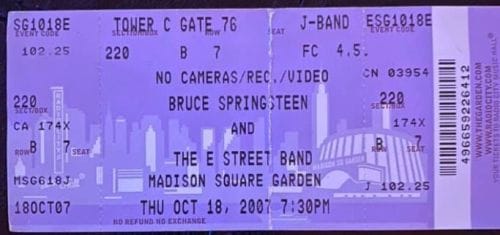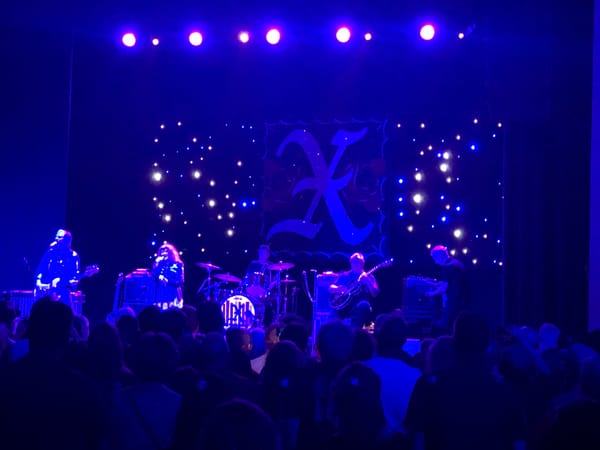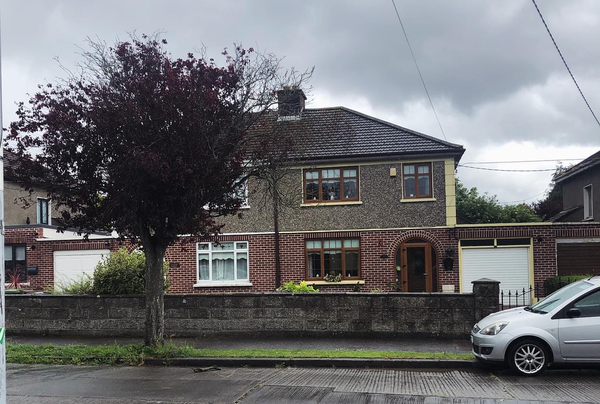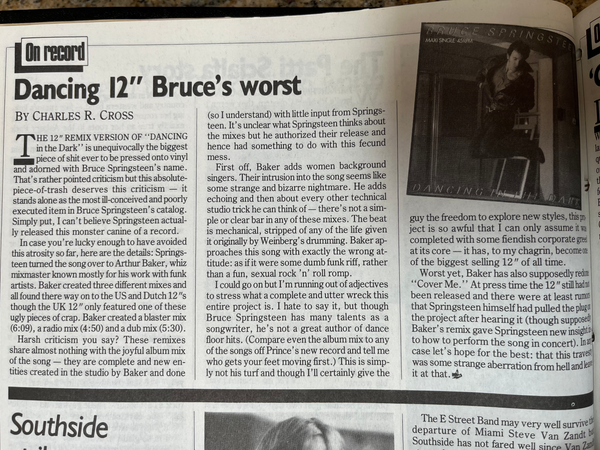Three Minute Record: Hank Ballard & the Midnighters: "Let's Go, Let's Go, Let's Go"
March 6, 2003
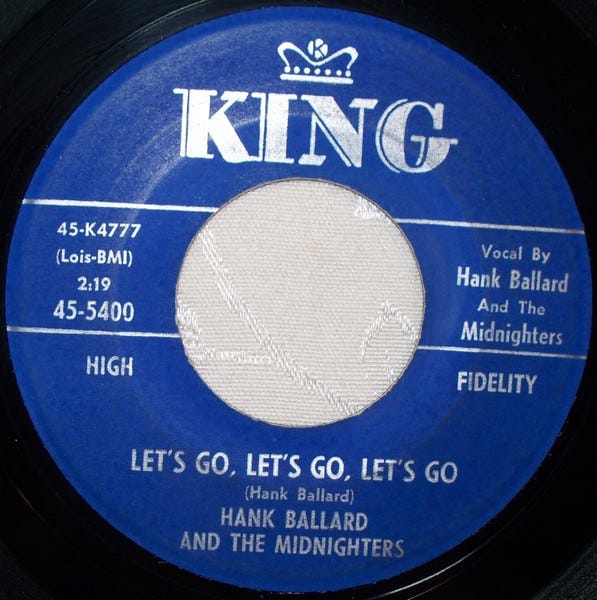
Welcome to Three Minute Record, the edition of this newsletter where we dive into Bruce Springsteen’s best cover versions. You can read more about the purpose of this exercise here and see other volumes here.
One of the finest musical performances Bruce Springsteen and the E Street Band have ever delivered in the post-Reunion era was at a show on the final leg of the Rising tour, at the Richmond Coliseum on March 6th, 2003, when the band performed Hank Ballard’s “Let’s Go, Let’s Go, Let’s Go.” This performance happens to feature Robbin Thompson, who was a vocalist in Bruce’s 1970-71 band Steel Mill, as well as Virginia native Bruce Hornsby on both vocals and accordion. But it’s not the guest appearances per se that make this performance exceptional.
“We’re gonna do a song I did once before1 -- a great, great father of rock ‘n’ roll passed away just recently by the name of Hank Ballard. Hank Ballard wrote ‘The Twist,’ he wrote ‘Sexy Ways,’ he wrote ‘Annie Had A Baby,’ he wrote ‘Work With Me, Annie.’ If you haven´t heard these, you oughtta go out and get ‘em. Hank Ballard -- a great, great father of rock´n´roll. He wrote this next song we’re gonna do and dedicate it to him and see how we do with it. All right, start it out, Roy.”
First of all, in the land of E Street, anything that begins with “Start it out, Roy” is guaranteed to be exceptional, because Roy Bittan is nothing short of exceptional. What makes him valuable to the E Street Band – or, hell, anyone engaging his services – is the directness, strength, and versatility of his playing style. There are not many musicians who could step into the studio for songs as colossally disparate as “Backstreets,” “Bat Out of Hell,” and “TVC15” and instantly become a fundamental element in the song’s structure. How do you deliver something completely different and yet eternally perfect each time?
Here, all Roy needs to do is deliver a simple boogie-woogie piano line, but the word “simple” here doesn’t mean “easy.” There’s a reason the great boogie-woogie piano players are in a class of their own. So Roy kicks off the intro, and then Bruce jumps in, backed up by the guests and anyone on that stage who has a mic stand. He’s got his soul singer voice out for the occasion -- we’re only a couple of months away from the 2003 Christmas shows with Sam Moore -- and it’s perfectly in range, not over-singing, not under-singing. I believe the technical term for the quality of Mr. Springsteen’s performance is “singing the shit out of it.” Yes, the lyrics are on the prompter, and even though one of the many things he is good at as a performer is making the audience completely unaware that he is using one, in this particular case he doesn’t need it because he knows this song inside and out, backwards, forwards, and sideways. He knows this song like we know “Born to Run,” you know? It was foundational. It’s a song that he loved and he knew and he sang and he listened to because he loved it.
Hank Ballard and the Midnighters released “Let’s Go, Let’s Go, Let’s Go” in 1960. Bruce Springsteen was 11, and was already paying close attention to rock and roll after that moment Elvis Presley invaded living rooms across America in 1956. He told us about dancing the Twist with his mom in the living room in “The Promise,” and then later in Born To Run. Hank Ballard wrote and performed “The Twist” in 1959, but Chubby Checker was the one who made it famous later. Bruce Springsteen was a student of rock and roll. He didn’t want to meet the Beatles, he wanted to be one of them. He would have paid attention to all of this later.
But let’s be clear: the reason the teenage Bruce Springsteen probably learned about Hank Ballard initially was because of “Work With Me, Annie,” which he mentions in his introduction to the song in Richmond. “Work WIth Me, Annie” was the Midnighters’ first major hit, going to #1 on the R&B charts. “Work With Me, Annie” was banned from radio airplay by the FCC because the powers that be determined that the song was about sex.
The Midnighters said “Awesome!” and proceeded to write two of what are called “answer songs,” which were basically attempts by other groups to capitalize on the popularity of another song. In the case of the Midnighters, this gave us “Annie Had a Baby” (I WONDER WHY) and “Annie’s Aunt Fannie” which is once again basically the same melody with Hank Ballard finding yet more euphemisms to talk about the joys of sex. (What all of these songs also share is a sharp, tasteful sax solo in the middle break.)
Unsurprisingly, both of these songs were ALSO banned by the FCC. They still sold records to the record-buying public, and undoubtedly got snuck onto jukeboxes at soda shops and drugstores across America, where adults rolled their eyes at kids these days with their rock music and didn’t actually try to listen to the song. This element of disinterest and disconnection is a major factor in what let rock and roll and rhythm and blues become a counter-culture unifying element for teenagers in the 50’s and 60’s. The adults had no idea what you were talking about, didn’t care, and didn’t even try.
Sidebar: “Annie Had A Baby” is actually an early pro-choice song because it talks about how “Annie can’t work no more” and yeah “work” probably meant “fuck” but it also definitely meant, you know, work.
The last hit that the Midnighters were best known for is a song called ”Sexy Ways.” I guess this is the point at which they said “fuck it” and didn’t even bother to try to work up another set of colloquialisms for doing it. There’s a lot of “ooowieeee”’s and then we get to:
Upside down
all around
Any old way
Just (something that sounds like ‘pound’ but could be ‘round’ or ‘town’ but is probably ‘pound’ given the context)
So while these may have been the way Bruce discovered Hank Ballard in the first place, they weren’t what he chose to perform on this night to pay tribute to someone who had an impact on him. There’s something about “Let’s Go, Let’s Go, Let’s Go” that was meaningful and significant enough to Bruce Springsteen that he named his home studio and his production company “Thrill Hill Productions” Let’s go back to the opening lines of the song:
There's a thrill upon the hill
Let's go, let's go, let's go
I also have to point out here that I don’t have any attribution on this. He’s never talked about it (names of production companies are not interesting or sexy to 99.999% of the population of the world) but I never stopped to consider it could have been inspired by anything else. That said, 2003 was the first time we have a documented instance of him performing it live, and I’m going to guess it’s because of the harmonization required to respectably deliver this song. It’s not just about having bodies that sing, or giving everyone in E Street a microphone -- this is not about “all must sing.” It’s about harmonies. The Midnighters got their start as a doo-wop act named the Royals, whose “Get It” was the direct inspiration for “Work With Me, Annie” (and yes, it was also full of sexual innuendo and while not outright banned by the FCC, many radio stations refused to play it for that reason).
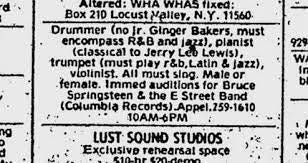
So let’s go back to the harmonies. This is 2003, where he has Patti and Soozie, but this isn’t about backing vocals, it’s about the type of range you have in a vocal ensemble. There are no Horns of Love who can fake their way through certain harmony structures. You’d have to go all the way back to the Bruce Springsteen Band, where Barbara Dinkins and Delores Holmes sang backup for a little while. He’s got enough singers tonight, though, and they know what they’re doing.
Listen to the range of emotion and controlled passion in Bruce’s vocal delivery in that first chorus and verse. A woman screams when Bruce gets to “Put on your pretty red dress/Let's go see about this mess” because he is inside the song, he is trying to sell himself, and it’s working very, very well, indeed. We are in the back half of the set, his voice is warm and wide open, and while it has a looser quality than Hank Ballard’s recorded version, that’s because of the times and the musical conventions and, again, that the Midnighters were originally a doo-wop group, a form that relies on precision as one of its many key qualities.
Bruce Springsteen then calls on Bruce Hornsby to take the next verse. But it’s not just singing Bruce S. wants, no, Bruce Hornsby is either there with an accordion or he borrowed E Street’s. First he sings his verse, it’s a little rough and I can’t tell if he’s tripping over the prompter scroll or if it’s a mic problem, but he still sells his verse respectably enough to get an audibly warm response from the crowd. And then you get the accordion break, and you wouldn’t be wrong to think that an accordion on a live E Street Band recording was Danny or Roy, but nope, here it’s Hornsby, who is a classically trained pianist and also played piano and accordion for the Grateful Dead on tour for many years. His verse ends with him stepping up and trying to pour on some hot buttered soul, and he does well, but my preference is Team Springsteen here.
Just when you forgot about the Midnighters’ love of a good saxophone break, Bruce cues the Big Man and Clarence elevates the performance and electrifies the room. The Midnighters’ saxophonist was fine! He is just not Clarence Clemons. (As we know, no one is.) But it’s one of those wonderful breakthrough moments in a Springsteen show, where Clarence just casually rips out a sax solo with confidence and power -- he doesn’t try to do more than the original did, but it still elevates it, and the audience is right there with him and explodes in excitement and appreciation at the end of it, everyone all together. Those moments were so special and so singular. You can hear it on the recording, you can feel it if you were fortunate enough to ever witness anything similar.
There sounds like there was some confusion at the soundboard after the solo, because it sounded like someone was going to play a guitar solo, and I don’t know if they were or weren't, or if it was supposed to be another accordion break and the mic just wasn’t on. But Clarence comes back in and fills the space until Hornsby can get back into the mix. Bruce S. attempts to orchestrate a key change which is a little rough but eventually successful, and the chorus repeats until Bruce says, “Let’s break it down.” The band (which of course has been steady and stalwart behind this entire outing) stops playing, and it’s just the vocals again, rich and gorgeous and satisfying, before sharply coming to a close, as it should. It’s just such an amazing moment, unexpected, special, uniquely E Street.
This is quite honestly probably my favorite E Street Band cover performance. It blew me away the first time I heard it, thanks to one of Flynn McLean’s fantastic tour compilations that he used to collect and compile and send out into the community, highlights from the tour so you didn’t have to try to track down every show just to hear things you’d read about on Backstreets. He’s never talked about Hank Ballard beyond this, he’s never played “Let’s Go, Let’s Go, Let’s Go” or any other Hank Ballard song ever again. This is probably something I should have thought about during the sign request era (RIP and do not ever return). Alas.
Hank Ballard was born in Detroit (Florence Ballard of the Supremes was his cousin) and passed away on March 2, 2003, in Los Angeles. He joined the Royals, who had been discovered by the great Johnny Otis and brought them to the a subsidiary of the legendary King Records in Cincinnati. They changed their name to the Midnighters because there was already a popular doo-wop act called the 5 Royales. Ballard rewrote the Royals’ “Get It” to become “Work With Me, Annie” and secured the Midnighters’ place in the annals of rock and roll history. They were inducted by none other than their fellow Detroiter, Smokey Robinson, into the Rock and Roll Hall of Fame in 2012. “They made you want to find somebody to dance with,” he said in his induction speech. That is a profound and concise definition of the heart of the beast, but an accurate one in this case.
Many thanks to Flynn McLean and Jamison Foser for their help in getting me missing audio files.
(the previous show in fact) ↩

